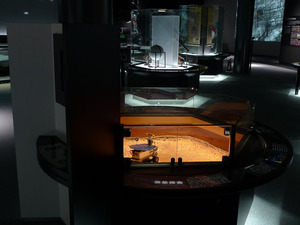Nagoya City Science Museum
TOP > Exhibition Guide > Floor Map> Exploring Our Solar System
Exploring Our Solar System



Purpose of Exhibition
Sputnik 1, the first artificial satellite in human history, was launched in 1957. Since then, many satellites have been sent up and planetary probes have left the earth’s gravity sphere to explore planets, asteroids and comets in the solar system. The planets are so distant that we can’t view their surfaces from earth. However, spacecrafts can observe the surface of a planet in detail from close up. Also, by observing changes in the motion of a spacecraft, we can learn more about the planet’s interior, such as the strength of its gravity. Furthermore, by landing on the surface and examining the rocks there, we can obtain clues to how the planet was formed.
This exhibit will show you the history of space exploration, in particular the methods and the difficulties, for each target object, and provide you hands-on experience with a miniature rover.
Additional Knowledge
[History of Planetary Exploration]
In 1959, the former Soviet Union’s Lunar Explore Luna 1 flew away from the earth and became the first spacecraft to observe celestial bodies other than the earth, followed by the Venus Explorer Mariner 2 in 1962 and the Mars Explorer Mariner 4 in 1965. Voyager 2, launched in 1977, made close approaches to Jupiter, Saturn, Uranus and Neptune, and achieved significant observation results. Today, probes have been sent to all the planets in our solar system, and even to comets and asteroids.
[Time Delay in Planetary Exploration]
When a spacecraft works far away, it takes a long time to receive commands from the earth, which is called time delay. In the case of Mars, even when close to the earth, about four minutes is needed for one way. So, it would take almost nine minutes to get a status report back from the spacecraft after we send a signal. Accordingly, we have to make sure that the probe itself can judge the situation and act on its own. When the asteroid explorer HAYABUSA collected rock samples from an asteroid named Itokawa, it also made autonomous decisions in this way.
This page was last edited on 30 June 2022.
Article by Astronomy Section
